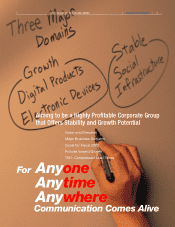Toshiba 2002 Annual Report Download - page 19
Download and view the complete annual report
Please find page 19 of the 2002 Toshiba annual report below. You can navigate through the pages in the report by either clicking on the pages listed below, or by using the keyword search tool below to find specific information within the annual report.
17
TOSHIBA CORPORATION
A VIEW TO THE FUTURE 17
TOSHIBA CORPORATION
timedia products and technologies. Mobile
phones with cameras, digital still cameras and
replacement HDDs are expected to continue
to be in high demand. Toshiba’s basic strategy
is to build on its technological strengths and to
lead the way in mass-producing high-value-
added products while promoting measures to
further raise cost competitiveness, especially
using multi-level cell process technology ahead
of competitors. One advantage that we will
fully leverage is the fact that Toshiba invented
NAND flash memory and owns essential IP
rights. This will provide us with positive sup-
port in many areas, including efforts to
enhance multi-chip packages (MCP) for mo-
bile phones that integrate NAND flash, NOR
flash, SRAM and PSRAM in a single package.
A further plus will come from the construction
of 300mm wafer lines at Yokkaichi, scheduled
to start in 2005 and to begin mass production
in 2006. Investment in the facility and its
equipment is expected to total around ¥150
billion.
System LSIs
Toshiba is determined to focus on two areas:
digital consumer and mobile. Advanced SoC
now accounts for a little over 25% of Toshiba’s
system LSI business. Our goal for 2005 is to
take that to beyond 30%. We are working to
fortify new product proposals and constantly
searching for new markets for SoC products.
Our commitment to integrating cutting-edge
technologies and realizing new levels of func-
tionality are exemplified by an image
processing LSI that support high-capacity,
high-speed processing. Our concentration on
such value-added products and differentiated
technologies also supports us in forging alli-
ances with leading companies in our target
areas. For instance, in the CMOS image sensor
business, we have maintained strategic collabo-
rations with major phone manufacturers and
increased market share as the market for mo-
bile phones with cameras has grown to become
the mainstream.
Another undoubted asset is our ability to pio-
neer new levels of process technology—the secret
to advances in miniaturization and device func-
tionality. We were first in the industry to deploy
90nm process technology and we have already
gone beyond that to realize 65nm process tech-
nology. These capabilities will be further en-
hanced by fabrication of 300mm wafers at our
new LSI facility at Oita Operations, our LSI pro-
duction facility. Construction of this advanced
facility started in June 2003 and mass production
is scheduled for the first half of 2004. Once full
capacity is reached output will climb to 12,500
wafers a month. Investment is expected to total
around ¥200 billion, with the first ¥40 billion
directed to construction of the building and
clean room in this fiscal year. The main product
of the facility will be advanced broadband pro-
cessors, a product area where we anticipate high
demand in future. Production will draw on our
strengths in system LSI with embedded DRAM
process technology. While first-generation prod-
ucts will be manufactured with 65nm process
technology, we will make an early transition to
the 45nm design rule in the future.
Discretes
While Toshiba remains the clear No. 1 in the
world discrete devices market, that does not
mean any relaxation in our efforts or commit-
ment. On the contrary, we will continue
efforts to expand business and improve cost
competitiveness. Toward these goals, we are
pushing for a stronger presence in the Chinese
and Korean markets, today’s two main growth
markets, developing differentiated core prod-
ucts and transferring assembly to China.
アニレポp1-26( 英) 6 .18 03 .6.25, 8 :05 PMPage 17 Adobe PageMaker 7 .0J / PPC
























